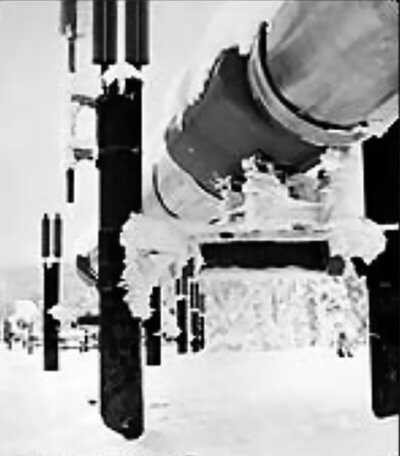Pipeline Designs to Protect Permafrost

I first heard about this in August 1969. I met an old colleague, Irv Tailleur, and he said, 'Art, did you realize the Trans-Alaska people have put in a request to Secretary of the Interior Hickel to build a pipeline? The pipeline will be buried in a trench, mostly in permafrost.' And we looked at each other in sort of a manner of disbelief." — Art Lachenbruch, U.S. Geological Survey
Geological Problems
Art Lachenbruch was a geologist at the U.S. Geological Survey (USGS) in Menlo Park, California, when he first caught wind of the Trans-Alaska pipeline project. Lachenbruch was an expert in permafrost, the rock-like layer of frozen soil just below the thin, insulated cover of soil and vegetation. In December 1970, he released a study in which he explained the damage a hot pipe would inflict upon the permafrost. At a temperature of 158 to 176 degrees, the oil in the pipe would thaw a cylindrical area 20 to 30 feet in diameter within a decade. The thawing would cause damage not only to the pipe, but also to the landscape. It's legend at the USGS that Lachenbruch's conversation with Tailleur -- in the office men's room -- led to the complete redesign of the pipeline.
Redesigning the Pipeline
With 75% of the 800-mile pipeline passing through permafrost terrain, the engineers came up with three principal redesign plans to fit the needs of each particular area. The consortium of oil companies building the pipeline, Alyeska, buried 380 miles of the line. Four hundred and twenty miles would be elevated on supports or pilings. The soil on every inch of the pipeline would be tested to figure out which design worked best.
Conventional Buried Pipe
The designers determined that they pipe could be buried in three types of ground: permanently thawed soils, bedrock, and some areas of permafrost which, when thawed, were considered unlikely to cause damage to the pipe. This permafrost was usually a mixture of sand, gravel and ice. Although the method was conventional, the pipeline was not buried like other oil pipelines, like the ones in Texas, which are generally buried in a ditch at a uniform depth. Instead, in Alaska, depending on soil conditions, the engineers buried the pipes at depths of three to twelve feet. This method was used for 376 miles of the pipeline's total length.
Elevated Pipe
"There are 78,000 VSMs [vertical support members] and every single one of those had a 24-inch hole drilled for it and every single one of them had a qualified person analyzing what came out of the hole to determine what kind of VSM it should be. There was actually a field design manual that was based on the soil." — Bill Howitt, Alyeska engineer
Across 420 miles of the pipeline's route, where the permafrost was unstable and the pipe could not be buried, the engineers designed vertical support members (VSM). These H-shaped pilings elevate the pipe several feet above the ground. The pipe is placed in a Teflon-coated steel shoe that sits on top of the crossbeam. This allows the pipe to slide sideways as it expands (when it's hot) and contracts (when it's cold). In particularly sensitive areas where the permafrost hovers just above the freezing temperature, the engineers added a passive refrigeration system. At those sites, each VSM was equipped with a pair of tubes that sit inside the VSM and descend into the ground. The tubes are filled with anhydrous ammonia, which absorbs the heat, releases it in to the air and then circulates back into the ground.
Buried Pipe with Refrigeration
For four miles of the route, neither the conventional buried method nor the elevated one was possible. At these locations, pipe had to be buried in the permafrost to avoid getting in the way of the highway or animal migration as well as a precaution against rockslides and avalanches. These stretches of pipe got their own refrigeration system. The pipe sits on two six-inch coolant pipes. Refrigerated brine is circulated through these lines, powered by electric motors that are housed in a nearby building, which also contains a heat exchanger that removes the heat from the coolant to the outside air. The brine goes into the ground at 8-10 degrees Fahrenheit and comes out at 18-21 degrees Fahrenheit, absorbing a significant amount of heat from the oil in the pipeline.






